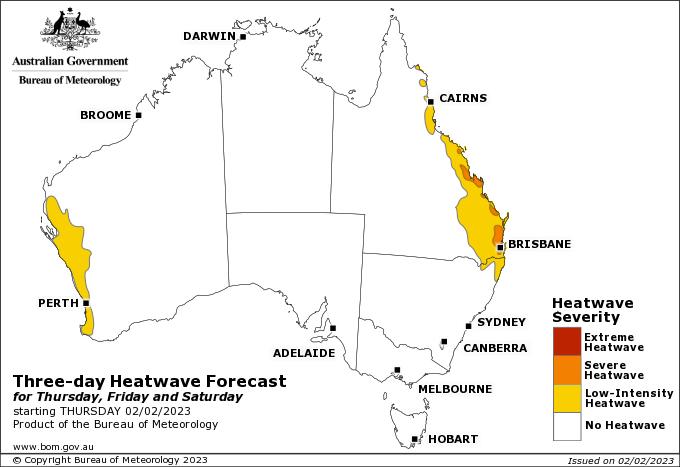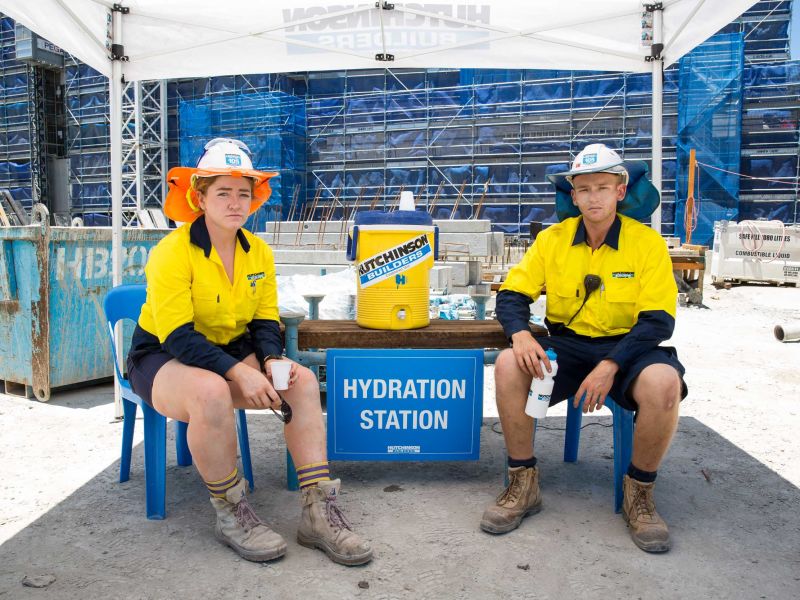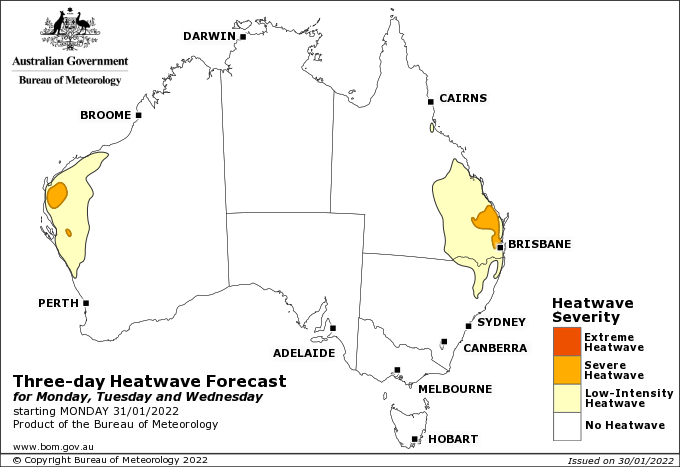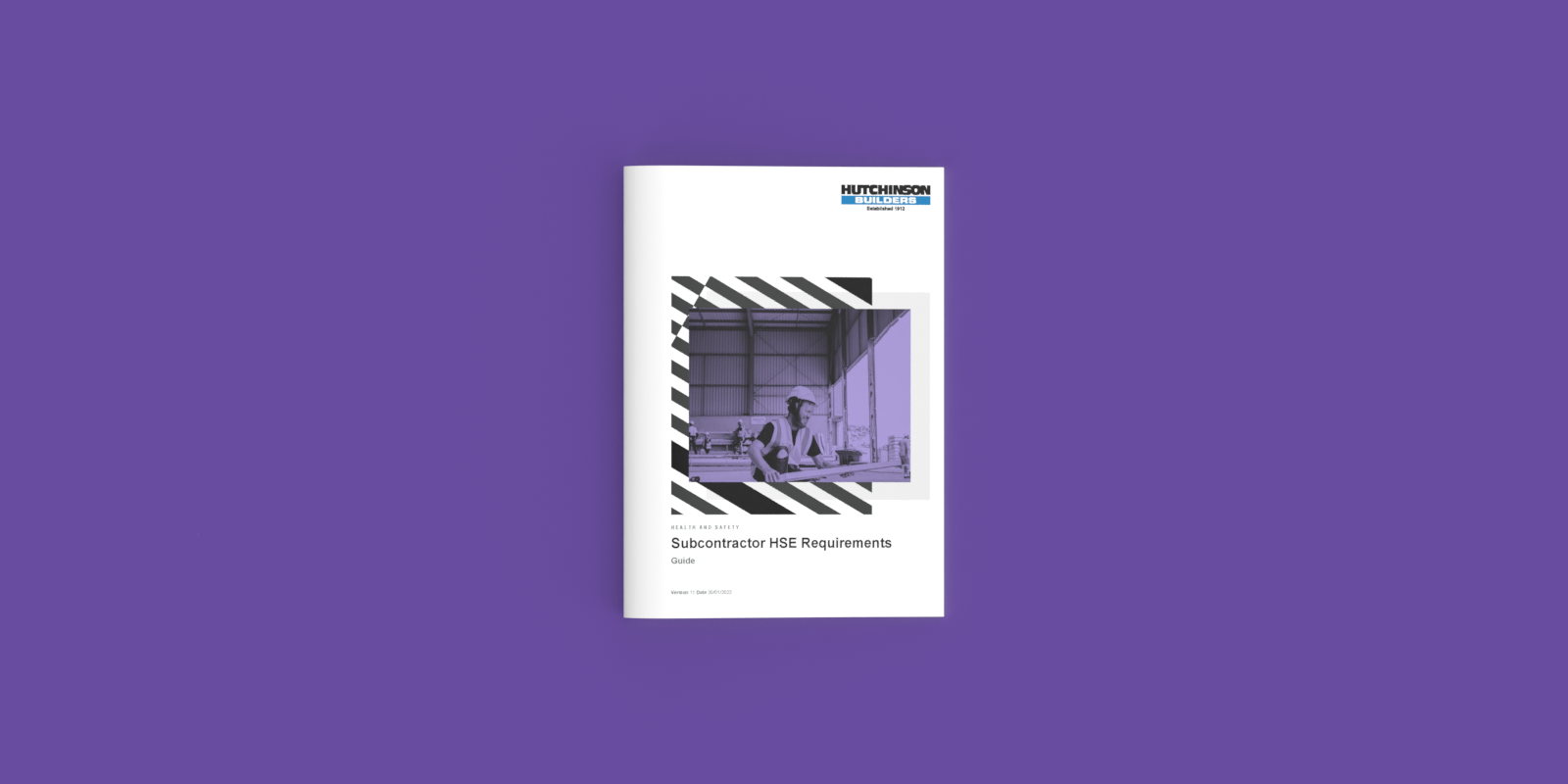Activities & Alerts
Low to severe heatwave conditions are forecast over the next 3 days.
Particular areas include the Queensland tropical and central coast, including South East Queensland and Northern New South Wales.

Working in hot conditions
Awareness, education and preparedness are the key factors in recognising and countering the potential risk to health of workers when working in hot environments.
The Bureau of Meteorology (BOM) has issued warnings for severe heatwave conditions in parts of Southern QLD and Northern NSW.
These conditions are forecast over the next 3 days for areas reaching from Brisbane to Gladstone, and parts of border areas around Northern New South Wales.
Working in hot conditions
Awareness, education and preparedness are the key factors in recognising and countering the potential risk to health of workers when working in hot environments.
Hutchies' Subcontractor HSE Requirements document is a summary of safety expectations for all of Hutchies' projects.
The Subcontractor HSE Requirements is referenced in all subcontract agreements (Annexure E) and is used in conjunction with local legislated requirements and Hutchies' Safety Management System.
To accurately reflect our current HSE requirements, this document has been updated to include:
- The use of HammerTech on all projects
- Incident notifications and investigations
- Rehabilitation and return to work
- Plant and equipment maintenance
- Minimum Licencing Requirements
Prior to commencing on site all subcontractors shall be provided access to the following WHS documentation via our Subbies Toolbox:
- WHS Management Plan
- Project Risk Assessment
- Site Rules
Action
HammerTech
The document has been uploaded to all HammerTech welcome emails and will be automatically attached to the welcome email which you need to send to each new Subcontractor as they are onboarded into HammerTech.
Project Teams
- Add subcontractors to HammerTech in advance of their commencement and then send HammerTech's 'welcome email'
- Update any team specific process or project specific Subcontractor HSE documentation to reflect this latest content
Future updates of this document will be automatically attached to HammerTech's 'welcome email'
Falls and falling objects are hazards which can occur on construction sites. Constant proactive attention is required to manage the risk of these hazards due to the dynamic nature of site.
Site management and all workers have a duty to provide and maintain a safe workplace for all everyone that puts ‘people before program’.
By working together on Hutchies’ sites with good communication and planning, we improve the safety of ourselves and everyone around us. This extends to visitors to site and members of the public who may interact with our projects.
Actions
All Site Management Teams are to:
> Download and display the Big 10 poster on your site to raise awareness
> Deliver a toolbox talk (download template) at the next prestart to the site teams / workers to communicate the Big 10 as well as the below actions for workers
> Complete a Weekly Inspection – Big 10 in HammerTech every week to monitor and review the effectiveness of implemented control measures and identify areas that require attention or rectification
specifically review the falls and falling object control measures:
- Housekeeping
- Scaffold
- Penetrations
- Edge protection
> Raise any issues or observations that are identified with the relevant trades to achieve an effective and timely close out
> View the short videos below as a refresher for the required risk controls
All workers should are to:
> Follow Hutchies’ site rules & obtain relevant permits to work
> Follow approved Safe Work Method Statements (SWMS
> Consider changes to the work environment that may affect approved SWMS as work progresses
> Install required and approved exclusion zones correctly prior to starting work
> Do not enter an exclusion zone unless you have approval from the trade in control of the area
> Do not alter scaffold on site unless you are a licensed scaffolder and have been instructed to by Hutchies
> If required to use height safety equipment, be competent and suitably trained before and use it in accordance with the manufacturer’s guidelines
Remember, your Hutchies’ site management team is available if you need any help or you see something that is potentially unsafe.
By working together effectively, we can improve the safety for everyone on site and reduce the risk of incidents

The Bureau of Meteorology (BOM) has issued warnings for extreme heatwave conditions in areas of southern QLD and northeastern NSW from this Sunday through Tuesday.
Sydney and areas of NSW, NT and QLD are also currently experiencing low-intensity to severe heatwave conditions today, which are expected to continue over the coming days.
The below linked BOM maps illustrate the areas expected to reach high temperatures today through Wednesday.
HILTI DGH 130 Multi Speed Concrete Grinder
### To be removed from service until further notice ###
A recent event occurred where the cup stone disc separated from a HITLI DGH 130 during operation. This event is currently under investigation. Picture provided below.
ACTION REQUIRED
This model tool is to be withdrawn from operations and tagged out of service until the investigation establishes the cause of the tool failure which resulted in the cup stone disc becoming dislodged from the tool.
This tool cannot be put into active service until formal notice from Hutchies’ National Health & Safety Manager.
FOLLOW UP
This out of service advice does not apply to any other HILTI tool or product.
Formal advice as to further action will be distributed when known.
## UPDATED ##
This alert supersedes the order that came into effect 22 July 2020.
The Victorian Government has expanded their order for mandatory face coverings / masks across the entire state of.
Everyone over the age of 12 will now be required to wear a face covering when leaving home for one of the four permitted reasons.
This order will be enforced from 11.59pm on Sunday 2 August 2020. People who do not comply will face a $200 fine.
The Victorian Government has acknowledged that in some circumstances, wearing a mask may be impractical, however everyone is expected to carry a mask or face covering for use whenever practical. More info here.
The Victorian Government has issued the following order to people living in metropolitan Melbourne and Mitchell Shire.
Everyone over the age of 12 will now be required to wear a face covering when leaving home for one of the four permitted reasons.
This order will be enforced from 11.59pm on Wednesday 22 July 2020. People who do not comply will face a $200 fine. The Victorian Government has acknowledged that in some circumstances, wearing a mask may be impractical, however everyone is expected to carry a mask or face covering for use whenever practical. More info here.
Hutchies has updated our Keeping People Safe Plan (Version 2), which outlines our response to coronavirus.
The plan updates include:
- Latest information on the requirements and measures in place for COVID-19
- New procedure for managing a positive case on a Hutchies project
- How to conduct essential site visits / inspections
Please ensure you throughly read through this updated copy and implement any necessary measures if you haven't already.
This latest plan can also be shared with our clients, consultants, subcontractors, suppliers and anyone else who may need to enter a Hutchies project site or office to understand the measures we have in place.
All,
The current measures put in place by the Federal and State Governments to control the spread of coronavirus DO NOT include shutting down construction sites.
Therefore ALL Hutchies projects are open for business.
In order to keep construction sites open, it is essential that we continue to implement all of the necessary social distancing and hygiene measures across our sites and offices and we will provide further updates as things evolve.
Also, please ensure all of the subcontractors on your sites are aware of the social distancing and hygiene measures we have implemented and that our projects are working.
Ben Young
Workplace Relations Director
Hutchies
All,
Please refer to the attached important information below about coronavirus and resources we have made available on Hutchies’ Toolbox for immediate use across all offices and sites.
Ensure you read and print the attached poster for display around Hutchies’ offices and job sites as soon as possible.
Thanks
Greg Quinn
Managing Director
Hutchies
Alert 64 / Unsecured Infill Packers at Loading Bays
Hutchinson Builders recently experienced a dangerous event that involved the uncontrolled release of a 1200mm x 1800mm x 16mm sheet of ply that had been used as an infill packer in front of a Preston loading bay.
The sheet of ply was shunted out past the external edge of the concrete slab by the action of the loading bay being shifted to the extended position thus causing the ply to become a falling object. There were no injuries incurred in this event.
Background
At times there is height differential between the surface of the concrete slab and the deck of the Preston loading bay. This height difference can cause an issue in controlling the passage of loads being transported to and from the loading bay.
The installation of packing sheets in either temporary or permanent situations is occasionally applied as a local solution. Packing sheets that are not mechanically secured to the concrete substrate can present as a falling object hazard.
Desired Outcome / Solution
In order to eliminate the potential for falling object hazards of this nature it has been determined that any ply, checker plate or other material that is utilised as an infill packer in front of a Preston loading bay is to be:
- mechanically fixed to the floor slab
- inspected at intervals to ensure that the integrity of the mechanical fixings are maintained.
Understanding the Changes to Concrete & Earthquake Codes
An ADG guide has been produced to help everyone understand the changes to Concrete and Earthquake Codes which is now available below.
These changes affect all buildings in all areas. This may affect the costing of jobs due to the required changes.
Does this apply to me / my project?
YES, it applies to all projects nationally where the project is approved on NCC2019. This means any project with a building approval issued after 1 May 2019.
All current projects based on NCC2016 or earlier remain on the existing AS1170.
Please ensure all products/systems comply with this, including imported products and systems such as curtain walls.
Downloads
Click the below to download the ADG guide that explains the changes in detail. QMBA and QBCC provide additional information on their websites below.
Temporary Fire Services including hydrants, fire hose reels and extinguishers are a requirement of the National Construction Code. They provide protection against the potential risk of fire on a building site during construction. Refer clause E1.9 below for specific details.
On building sites, there is risk of fire from construction activities, materials and fuel.
This may pose a significant risk not only to people and the project but also to neighbouring properties.
It’s important to remember that a building site does not have the permanent fire protection systems that protect people and property when the building is complete.
A summary of the requirements can be found here.
What do I need to do from here?
As always, careful planning of the works is necessary. Ensure that this requirement is managed through design.
Then, during construction, implement the requirement in a timely manner to ensure a compliant fire protection system is in place as soon as possible, and before the limits are reached during construction.
All projects need to have a programme that considers the activities and timing required to ensure compliance. Please ensure lead time works including boundary connections, procurement etc are included and a milestone linked to the E1.9 criteria are included.
Keep in mind boundary connections are usually a long process and may impact on permanent water sources for example, so temporary services may be necessary as an interim, where approved by the relevant authorities/designers.
Ensure consideration is given to any water tanks and fire pumps that are required to maintain the fire services protection at all times.
Please ensure safety audits include for regular checking for compliance of these requirements.
If there are any issues with achieving strict compliance, consult the Building Certifier/Building Surveyor/PCA, and any relevant Regulators and Fire Brigades to ensure the works don’t progress without suitable fire protection.
| Check the relevant state legislation for more information: | ||
|---|---|---|
| QBCC – 2018/19 Compliance and Enforcement Strategy | ||
| QBCC – 2017 Contractual Obligations, Demerit Points and Bans | ||
| QBCC – Defective Work & Disputes | ||
| VBA – Compliance & Enforcement | ||
| VBA – Performance Audits | ||
| NSW – Licence Holder Overview |

The Bureau of Meteorology (BOM) has issued warnings for low to locally severe intensity heatwave conditions over southern QLD and northeastern NSW.
Please ensure you stay hydrated, wear appropriate protection (clothing, hats, sunscreen etc) and look out for your mates.

The Bureau of Meteorology (BOM) has issued warnings for low intensity heatwave conditions through northern parts of the country including parts of WA's Gascoyne and northern districts, NT's Barkly to Tanami districts, lastly QLD's northeastern coastal to across southeastern areas where conditions grade locally to severe within the central east. Low intensity heatwave conditions extend across the border through northeastern NSW.
Please ensure you stay hydrated, wear appropriate protection (clothing, hats, sunscreen etc) and look out for your mates.

Inhalable dust, respirable dust and Respirable Crystalline Silica (RCS / Silica Dust) remains an important risk factor for respiratory disease amongst construction workers.
The following information has been compiled in order to address some of the queries that arise on the topic of silica dust management.

Awareness, education and preparedness are the key factors in recognising and countering the potential risk to health of workers when working in hot environments.
What is Heat Related Illness?
Heat related illnesses occur when heat builds up in the body faster than the body can lose it. Excess body heat can occur when a person is exposed to extremes of temperature and humidity, and when generated from exertion or physical activity.
Factors that may contribute to heat related illnesses:
- the temperature/humidity and movement of the surrounding air
- the type and duration of work activity
- an persons physical condition, in particular when not acclimatised to conditions and/or activity
- insufficient hydration
- medical conditions (hypertension, diabetes) and some medications and substances.
How do we recognise the symptoms?
Heat related illness can range from mild heat rash or cramps through to heat exhaustion.
Some of the key warning signs include:
- muscles spasms or cramps
- heavy sweating in the early stages, and in the latter stages no sweating at all
- abnormal displays of confusion
- slurred speech
- blurred vision dizziness or fainting.
What can we do about it?
Reducing the onset of a heat related illness can be achieved by applying the following considerations;
- rescheduling work so the hot tasks are performed during the cooler part of the day;
- where possible, reducing the time spent doing hot tasks (for example, by job rotation);
- where possible, arranging for more Workers to do the job;
- providing extra rest breaks in a cool area;
- providing cool drinking water and ice (machines) near the work site.
- increasing air movement by fans or coolers
- installing shade cloth to reduce radiant heat from the sun
- giving consideration to working an eight hour day
- Educating Workers with respect to hydration and heat and fatigue management.
The following ‘Hydration Chart’ is a quick and easy way for workers to monitor their hydration level as one process in the steps to avoiding heat related illness.
These Hydration Charts should be placed in site toilet and other prominent locations as prompts for all workers.
Outcome
Through the application of this safety alert workers should be able to monitor themselves and their mates whilst working in hot conditions and avoid unnecessary injury or illness as a result of the hot weather conditions.
What do we do in Extreme Hot Weather
Where the temperature reaches 35oC there will be an orderly cessation of work and preparations for the safe completion of critical task that are underway and/or applicable modifications to the workload.
Where the temperature is 28oC and the relative humidity is 75% or more after three hours from the commencement of a shift there will be an orderly cessation of work and preparations for the safe completion of critical task that are underway and/or applicable modifications to the workload.
If there are areas of the workplace that are below these climatic conditions work shall continue as normal in those areas. Employees unable to work elsewhere may be transferred to these areas if work is available. Employees may walk a reasonable distance through the open to and from amenities, provided it does not pose an imminent risk to their health or safety. The primary objective is to ensure that there is no reasonable concern for risk to the health or safety of an Employee undertaking the work.
The onset of these climatic conditions is the trigger to implement Heat Management controls and to redeploy workers to other areas of the site that is not impacted to the extent of the temperature and humidity guidelines. Extreme hot weather shall be measured on site by a temperature gauge which is compliant to the relevant Australian Standards and shall be undertaken in accordance with the manufacturers operating instructions and/or BOM weather station. There are a number of appropriate temperature gauges that meet this criteria, of which the Wet Bulb device is one.
Health & Safety Alert 061 has been published relating to underground services identification below. Should further information or assistance be required please do not hesitate to contact Danny O’Reilly (danny.oreilly@hutchinsonbuilders.com.au / 0408 920 496).
This Alert has been updated to include a new version of SWMS 07 - Excvation, Trenching & Ground Penetration (Version 10 - September 2018) now available on the Hutchies Doc Library via the below download.
Background
A recent incident occurred on a Hutchinson Builders (HB) controlled project where underground High Voltage services were struck by an auger. Investigations into this incident have identified opportunities for improvement in the risk management processes and training requirements where excavations, trenching, and ground penetration activities are included in the HB scope of work.
The current process requires that ‘Dial Before You Dig’ (DBYD) resources are consulted to locate underground services prior to commencing excavation, trenching, and ground penetration activities. Past experience has demonstrated that the DBYD information has at times been incomplete or inaccurate and therefore unmapped underground services, and existing services locations have been found that were not included in the DBYD records.
Note DBYD does not claim that it is a complete register of all buried services as not all Local Authorities or service providers are contributors to the DBYD network; for example Gold Coast Council is not a contributor to DBYD therefore the water, sewage and other council assets in this location are not registered with DBYD.
Objective
To service the obligation that is owed by ‘a person with management or control of a workplace’ as described in the following extract from the Safe Work Australia Code of Practice for Excavation Work, and that is reflected in Legislation in all States and Territories in Australia;

Accordingly the following risk management instruments have been updated and will be released to the Toolbox when the document review and consultation process has been completed;
| Current Instrument Title | Revised Instrument Title | Summary of Revision |
| SWMS 07 – Excavation & Trenching Version 9 March 2016 | SWMS 07 – Excavation, Trenching & Ground Penetration Version 10 | **NEW SWMS AVAILABLE** Content revised to more clearly reflect identification and documentation of underground service locations. |
| HB-HSEQ-F-078 Excavation & Penetration Permit Version 9 | HB-HSEQ-F-078 Excavation, Trenching & Ground Penetration Permit Version 10 | Title changed to include Excavation, Trenching & Ground Penetration. Content revised to more clearly reflect identification and documentation of underground service locations. |
| 2.0 Work Health and Safety Management Plan – Appendix 1 Version 10.2 | 2.0 Work Health and Safety Management Plan – Appendix 1 Version 10.3 | Excavation Section content revised to more clearly reflect identification and documentation of underground service locations. |
| HB-HSEQ-F-023 Design Risk Assessment Version 5 | HB-HSEQ-F-023 Design Risk Assessment Version 6 | Section 5 expanded to include aspects related to Excavation, Trenching and Ground Penetration, with specific reference positive location of underground services, and the consideration of such services in design. |
Intended Outcome
Effective 1 October 2018 all projects where the scope of works involves excavation, trenching, and ground penetration activities in areas under the control of Hutchinson Builders shall;
At Design Stage (where applicable):
- Undertake a detailed survey and positive location of all underground services in the affected area and develop a detailed underground services plan that provides concise information as to the nature and location of all underground services
- Utilise the information gained in the underground services survey to contribute to a design that addresses the risk associated with working in the vicinity of the services in question
At Construction Stage:
- Utilise the detailed underground services plan, where available, that has been developed at design stage to manage the risk associated with working in the vicinity of underground services
- Where such an plan is not available, undertake a detailed survey and positive location of all underground services in the affected area and develop a detailed underground services plan that provides concise information as to the nature and location of all underground services
- Make available all information related to the nature and location of underground services to any party engaged by Hutchinson Builders to work in the vicinity of underground services.
The location of underground services can be achieved by all, or a combination of the following example activities;
- Referencing ‘Dial Before You Dig’ records for the affected area
- Referencing as installed drawing from existing owner/occupiers
- Undertaking electromagnetic or other suitable scanning process to identify the presence of underground services
- Conducting non-destructive pot-holing to establish concise location of services in question.
Electromagnetic scanning and potholing are cost effective means that can be utilised to achieve the intended objective.
Failure to effectively control the hazards related to striking underground services can lead to
- risk to health and safety,
- damage to asset integrity,
- interruption to community facilities,
- significant cost penalty,
- damage to Company reputation and commercial relationships.
References
Safe Work Australia Code of Practice for Excavation Work – March 2015
State & Territory legislation relevant for the location of the works
More information
If you need additional support, please contact Danny O’Reilly
Phone 0408 920 496

Another uncorefilled masonry wall is blown over on a construction site – as we move to the summer months, winds historically increase considerably and this is s timely reminder of the importance of temporary bracing to these walls.
Please ensure we comply with the engineer's requirements for maximum heights of wall construction before corefilling is required as well as temporary bracing required AND the below downloadable guide found in the Doc Library and the WH&S system risk assessment and SWMS.
Safety Alert 060 - Inhalable dust, respirable dust and Respirable Crystalline Silica (RCS / Silica Dust) remains an important risk factor for respiratory disease amongst construction workers. Prolonged exposure to RCS can lead to the disease called ‘Silicosis’, which is a loss of lung function due to permanent scarring as a result of inhalation of silica dust over time. Safety Alert 060 has been published to assist with the control of exposure. Should further information or assistance be required please do not hesitate to contact Danny O’Reilly (danny.oreilly@hutchinsonbuilders.com.au / 0408 920 496)
Safety Alert 059 - The weather forecast for large portions of Eastern and Northern Australia predict that extremes in temperature will occur for a period commencing 10 Feb and could persist for more than one week. It is prudent that we ensure that our operational workplaces are appropriately equipped and prepared to address this period of working in hot conditions. Safety Alert 059 has been published to assist with these preparations. Should further information or assistance be required please do not hesitate to contact Danny O’Reilly (danny.oreilly@hutchinsonbuilders.com.au / 0408 920 496)
Safety Alert 57 - Please ensure that this information is presented at Toolbox Talks to all workers at Hutchies operational workplaces and yards and it is posted on Notice Boards. Records are to be maintained of Toolbox Talk attendees.

With the temperatures rising again please see the referenced alert and heat awareness posters. Hutchies' policy regarding the safe management of work in hot environments should be reiterated to all workers on all projects. Access more information in the Document Library.

